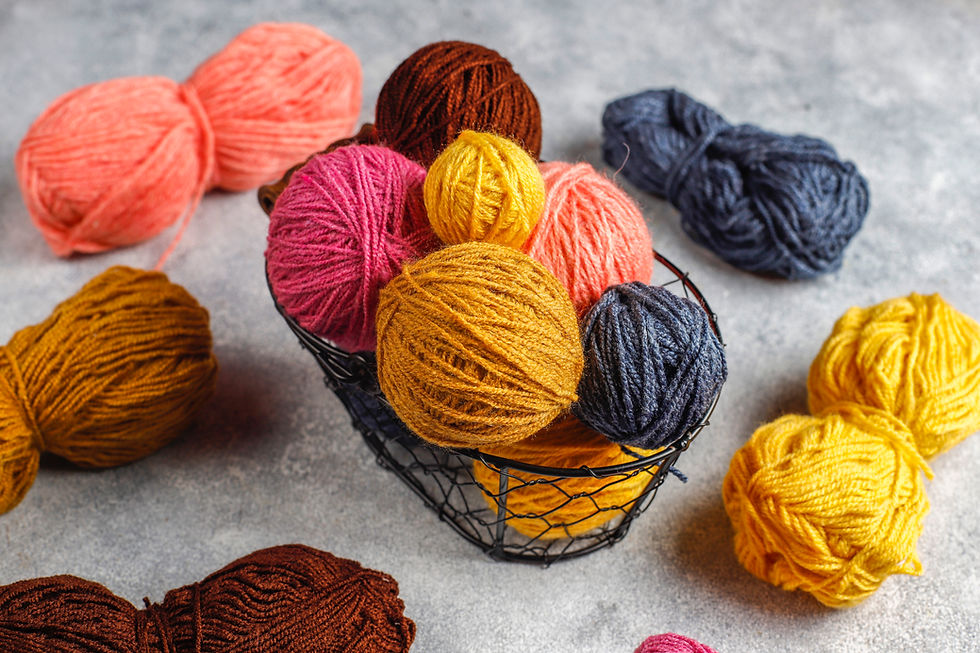Exploring Different Types of Needles: A Comprehensive Guide for Knitters
- suriyamanikandan4
- Apr 25, 2024
- 2 min read
Updated: May 5, 2024

Introduction:
Every knitter needs knitting needles to realize their creative ambitions; they are indispensable instruments. Picking the appropriate needles for your project requires considering several aspects, including the material type, size, and form. This thorough tutorial will discuss the various kinds of knitting needles, their special qualities, and how to choose the finest ones for your projects.
1.Understanding Needle Materials:
Bamboo Needles: Ideal for novices and anyone with arthritis or hand pain, bamboo needles are lightweight, flexible, and naturally provide a grip.
Metal Needles: Recognized for their resilience and sleek appearance, they facilitate rapid and seamless knitting, making them ideal for intricate lacework and expeditious projects.
Wooden Needles: Suitable for all kinds of knitting, wooden needles are renowned for their exceptional stitch control, warmth to the touch, and mild grip.
2. Exploring Needle Types:
Straight Needles: Traditional consecutive needles are used for flat knitting, such as scarves, blankets, and panels. They come in various lengths and materials to accommodate different project sizes and preferences.
Circular Needles: Versatile circular needles have two needle tips connected by a flexible cable, allowing for seamless knitting in the round. They are perfect for knitting hats, socks, sweaters, and shawls.
Double-Pointed Needles (DPNs): DPNs have points at both ends and are used for knitting small circumferences in the round, such as socks, mittens, and sleeves. They come in sets of four or five needles.
3. Choosing the Right Needle Size:
Gauge and Needle Size: The size of your knitting needles determines the gauge or tension of your stitches. Different yarn weights require corresponding needle sizes to achieve the desired fabric density and drape.
Needle Sizing Systems: Understanding needle sizing systems, such as US, metric, and UK sizes, helps knitters select the appropriate needles for their projects based on the yarn weight and pattern requirements.
4. Specialty Needles and Accessories:
Interchangeable Needle Sets: Interchangeable needle sets offer versatility and convenience, allowing knitters to customize their needle lengths and sizes for various projects without purchasing multiple sets.
Cable Needles: Cable needles create intricate cable patterns by holding stitches aside while knitting the crossing cables. They come in various shapes and sizes to accommodate different cable techniques.
Stitch Markers and Holders: Stitch markers and holders are essential accessories for keeping track of stitch patterns, marking increases and decreases, and holding stitches when working on multiple projects or complex designs.
5. Tips for Care and Maintenance:
Cleaning and Storage: Proper care and maintenance prolong the life of your knitting needles. Clean them regularly with mild soap and lukewarm water and store them in a protective case or organizer to prevent damage and loss.
Repairing Bent Needles: If your needles become bent or warped over time, you can gently reshape them by soaking them in warm water and bending them back into shape. Avoid applying excessive force or heat, as it may damage the needles.
Conclusion:
The right choice of needles is an essential tool for knitters, and it can greatly impact the outcome of your projects. By understanding the different types of needles, their unique features, and how to choose the best ones for your needs, you can enhance your knitting experience and unleash your creativity with confidence. Whether you prefer bamboo, metal, or wooden needles, a perfect pair out there is waiting to help you bring your knitting dreams to life.




Comments